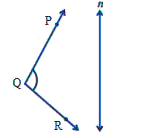Three forces P, Q, R are acting at a point in a plane. The angle between P and Q and Q and R are 150∘and120∘ respectively, then for equilibrium, forces P, Q, R are in the ratio
1:2:3
1:2:31/2
3:2:1
31/2:2:1
The correct Answer is:D
To solve the problem of finding the ratio of the forces P, Q, and R acting at a point in a plane, we can use the law of sines. The angles between the forces are given as follows:
- The angle between forces P and Q is 150∘.
- The angle between forces Q and R is 120∘.
1. Identify the Angles:
- Let the angle between forces P and Q be θPQ=150∘.
- Let the angle between forces Q and R be θQR=120∘.
- The angle between forces P and R can be calculated as:
θPR=360∘−θPQ−θQR=360∘−150∘−120∘=90∘
2. Apply the Law of Sines:
According to the law of sines, for forces in equilibrium:
Psin(θPR)=Qsin(θRQ)=Rsin(θPQ)
Substituting the angles:
Psin(90∘)=Qsin(120∘)=Rsin(150∘)
3. Calculate the Sine Values:
- sin(90∘)=1
- sin(120∘)=sin(180∘−60∘)=sin(60∘)=√32
- sin(150∘)=sin(180∘−30∘)=sin(30∘)=12
4. Set Up the Ratios:
Now we can set up the ratios:
P1=Q√32=R12
5. Expressing the Forces in Terms of a Common Variable:
Let P=k, then:
Q=k⋅√32andR=k⋅12
6. Finding the Ratio:
Now we can express the ratio of the forces:
P:Q:R=k:k⋅√32:k⋅12
Dividing through by k:
1:√32:12
To eliminate the fractions, multiply through by 2:
2:√3:1
7. Final Ratio:
Thus, the final ratio of the forces P, Q, and R is:
P:Q:R=2:√3:1
Conclusion:
The forces P, Q, and R are in the ratio 2:√3:1.
- The angle between forces Q and R is 120∘.
- Let the angle between forces P and Q be θPQ=150∘.
- Let the angle between forces Q and R be θQR=120∘.
- The angle between forces P and R can be calculated as:
θPR=360∘−θPQ−θQR=360∘−150∘−120∘=90∘
According to the law of sines, for forces in equilibrium:
Psin(θPR)=Qsin(θRQ)=Rsin(θPQ)
Substituting the angles:
Psin(90∘)=Qsin(120∘)=Rsin(150∘)
- sin(90∘)=1
- sin(120∘)=sin(180∘−60∘)=sin(60∘)=√32
- sin(150∘)=sin(180∘−30∘)=sin(30∘)=12
Now we can set up the ratios:
P1=Q√32=R12
Let P=k, then:
Q=k⋅√32andR=k⋅12
Now we can express the ratio of the forces:
P:Q:R=k:k⋅√32:k⋅12
Dividing through by k:
1:√32:12
To eliminate the fractions, multiply through by 2:
2:√3:1
Thus, the final ratio of the forces P, Q, and R is:
P:Q:R=2:√3:1
The forces P, Q, and R are in the ratio 2:√3:1.
Similar Questions
Three numbers p, q, r are such that pq=qr, where p,q,r>1 then the correct relation between q and r is :
View Solutionদেখাও যে, (p, q,r), (q,r, p) এবং (r, p,q) বিন্দু তিনটির সংযোগে একটি সমবাহু ত্রিভুজ উৎপন্ন হয়।
View SolutionThree numbers p, q, r are such that pq=qr, where p,q,r>1 then the correct relation between q and r is :
View SolutionThree forces P, Q and R are acting on a particel in the plane, the angle between P and Q and that between Q and R are 150∘ and 120∘ respectively. Then for equilibrium, forces P, Q and R are in the ratio
View SolutionThree forces P, Q and R are acting on a particel in the plane, the angle between P and Q and that between Q and R are 150^(@) and 120^(@) respectively. Then for equilibrium, forces P, Q and R are in the ratio
View SolutionThe points (p,q +r) , (q, r+p) and (r, q+p) are _______.
View SolutionDraw the images P' , Q' and R' of the point P, Q and R respectively in the line n (Fig . 9. 18). Join P' Q' and Q' R' to form an angle P' Q' R' Measure ∠PQRand∠P'Q'R' . Are the two angles equal ?

View SolutionThree forces P,Q and R are acting at a point in the plane. The angle between P & Q and Q & R are 150^(@) & 120^(@) respectively, then for equilibrium, forces P,Q & R are in the ratio
View Solution